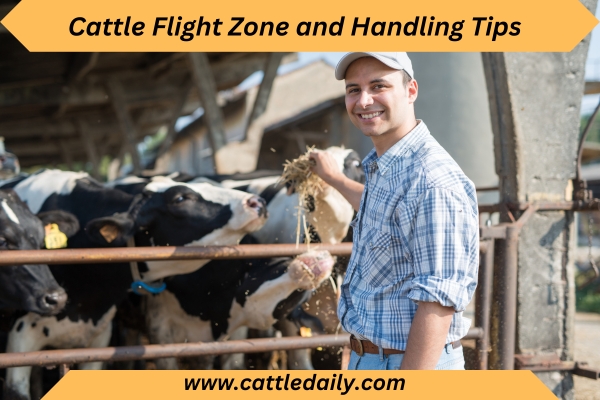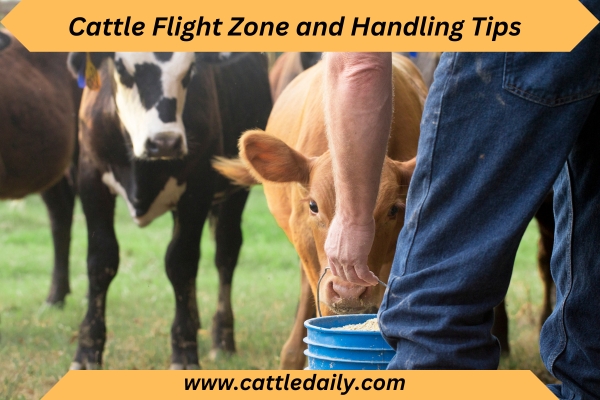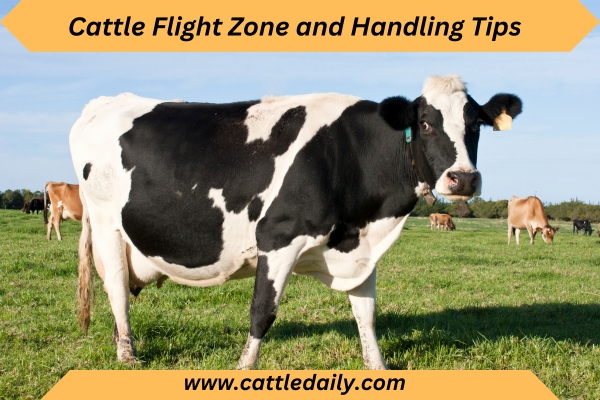Cattle Flight Zone and Handling Tips
Working with cattle requires an understanding of their instincts and behavior. One key concept is the cattle flight zone – the animal’s personal space that makes them feel safe.
When handlers enter or penetrate the flight zone, cattle will move away to regain their comfort. Knowing how to use the flight zone properly can make cattle handling much easier and less stressful.
In this blog article, we will discuss and provide a complete guide to respecting the cattle flight zone for safe, low-stress cattle handling.
What is the Cattle Flight Zone?
The flight zone is the area around an animal that makes them feel safe. As humans enter the flight zone, cattle will move away to regain their comfort zone. The size of the flight zone varies by factors like:
- Breed – Some breeds naturally have a larger flight zone, like English cattle, compared to Brahmans.
- Tameness – Tamer, frequently handled cattle have a smaller flight zone.
- Pen size – Flight zones are larger in open areas versus small pens.
- Handler movement – Fast, aggressive movements expand the flight zone.
- Weather – Hot temperatures or storms may expand the flight zone.
- Experience – Frightening experiences enlarge flight zones.
Understanding this concept allows handlers to use the flight zone properly when moving cattle.
Benefits of Respecting the Flight Zone
Handling cattle while remaining outside of their flight zone offers numerous advantages:
1. Reduced stress
The flight zone represents the cow’s personal space. When handlers enter this zone, it creates anxiety and stress as the animal tries to retreat to regain comfort. But staying outside the flight zone keeps cattle calmer since handlers don’t invade their safe space.
Low-stress handling is important since stressed cattle may have decreased milk production, reproductive issues, and compromised immune systems.
2. Increased safety
Entering a cow’s flight zone can trigger a fight or flight response. The animal may become aggressive toward an intruding handler.
However, remaining outside the flight zone significantly reduces defensive behavior like charging, kicking, or butting. Both handlers and cattle are safer when the flight zone is respected.
3. Easier movement
Handlers can leverage the flight zone response to initiate and control a cow’s movement. Approaching the edge of the flight zone will prompt the animal to move away.
This makes cattle more willing to move without force, while providing handlers an effective tool to direct cattle during sorting, loading, treatment, or relocation.

4. Lower injury risks
Aggressive handling that ignores flight zones is more likely to startle cattle and lead to accidents or injuries. However, slow movements and awareness of the flight zone create a calmer environment.
When cattle aren’t afraid or distracted, they are less likely to bump, kick or trample handlers.
5. Increased productivity
Since the flight zone is linked to stress, respecting it can boost productivity. Calmer cattle with lower stress levels tend to have improved immune function, vaccine response, weight gain, conception rates, and milk production. This is significant for cattle operations wanting to maximize performance.
Proper Use of the Flight Zone
Using the flight zone properly is key to smooth, effective cattle handling:
- Approach cattle slowly and quietly – Move deliberately but calmly when nearing cattle to avoid elevating their alertness or enlarging the flight zone.
- Work in the blind spot – Position yourself just behind the cow’s shoulder in their blind spot when handling or moving an individual animal. Reaching or approaching head-on may cause withdrawal.
- Penetrate the zone correctly – Step diagonally toward the edge of the flight zone to prompt forward movement. Move straight at the animal to stop movement.
- Control speed/direction – By moving back and forth along the perimeter of the flight zone, handlers can speed up, slow down, stop or turn cattle.
- Mind the point of balance – Locate yourself at the edge of the flight zone near the cow’s shoulder for optimal control over body position and movement.
- Shrink the flight zone – Gentle, consistent handling makes cattle less fearful, shrinking flight zone size over time.
- Utilize herd behavior – Use natural following instincts by moving the lead animal where you want the herd to go.
- Minimize distractions – Eliminate stimuli like flapping objects, dogs, or people that could dynamically expand the flight zone.
- Use handling tools – Sorting paddles, flags, or prods can penetrate flight zones from a safe distance.
In summary, properly using the cattle flight zone requires patience, practice and understanding of natural behavior. But it allows smooth, stress-free movement and handling for both cattle and handlers.

Common Cattle Handling Mistakes
It’s easy to make errors when handling cattle by not properly using the flight zone. Common mistakes include:
- Approaching head-on – Moving straight toward a cow’s head causes them to turn and retreat away from the handler. This withdrawal reaction makes them harder to control.
- Standing in the blind spot – Positioning directly behind the animal startles them when the handler moves, since they can’t see the human in this blind area.
- Sudden movements – Quick gestures or rapid approaches enlarge the flight zone, frightening cattle.
- Allowing distractions – Dogs, people, or flapping objects can dynamically expand the flight zone, making cattle more excitable.
- Excess noise – Shouting or loud noises elevate cattle stress. Agitated cattle become more difficult to handle smoothly.
- Overcrowding – Pens that are filled beyond capacity leave no room for handlers to move cattle within their flight zone.
- Aggression – Hitting, punching, or poking cattle in sensitive areas causes pain, fear, and stubbornness. Cattle may resist handling or become dangerous.

Tips for Low-Stress Cattle Handling
Follow these best practices for safe, calm cattle handling:
- Move slowly – Avoid rapid movements, running, or shouting which stress cattle. Be patient and deliberate.
- Develop trust – Frequent gentle handling accustoms cattle to humans, shrinking flight zones over time.
- Remove distractions – Eliminate barking dogs, flapping objects, vehicles, or unnecessary people.
- Well-designed facilities – Pens, chutes, and alleys should have no sharp turns or protrusions that impede cattle movement.
- Utilize herding instinct – Use natural following behavior to move cattle in groups.
- Consider a Bud Box system – Curved single-file chutes simplify sorting and loading while controlling cattle.
- Obtain handling training – Learn to read and react to cattle’s body language for smoother handling.
- Keep mothers and calves together – Calves should remain in sight of mothers to avoid distress.
- Monitor weather – Heat, cold, storms, or precipitation can make flight zones less predictable.
- Use positive reinforcement – Apply steady, light pressure on the flight zone then release when cattle move.
- Stop before exhaustion – End handling if cattle become dangerously agitated, tired, or stressed.
- Low-stress weaning – Gradually separate calves from mothers over time to reduce separation anxiety.
Be patient, eliminate distractions, understand cattle behavior, and design facilities to make handling easier on animals and handlers.
Cattle Handling Equipment
Specialized equipment can make handling more accessible and safer:
- Sorting paddles help move cattle by penetrating the flight zone from a distance.
- Flags extend reach and enable precise control over movement.
- Sorting sticks tap cattle to initiate movement without excessive force.
- Hobbles restrain movement by linking front or rear legs together.
- Halters provide control and close contact. Most effective on tame, trained cattle.
- Cattle prods or hotshots can prod movement but may elevate stress. Use as a last resort only.
With experience reading cattle’s body language and respect for the flight zone, handlers can move cattle fluidly and calmly. Always avoid forceful methods that will break down trust and skill.
Low-stress handling takes patience, practice, and close observation, but the payoffs in safety, efficiency, and productivity make it worthwhile. Careful attention to the cattle flight zone will lead to positive experiences for both handlers and animals. Learn here more about cattle behaviors and guides.


